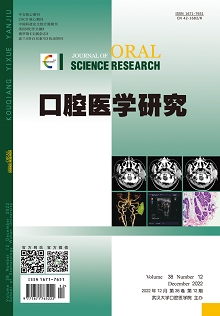|
|
Influence of Ferrule Heights and Crown-to-root Ratios on Fracture Resistance of Residual Roots Restored with Different Post-and-core Systems in Vitro
CHEN Yuxin, LI Yingmei, DU Chen, XU Zhiming, MENG Qingfei, MENG Jian
2022, 38(12):
1161-1166.
DOI: 10.13701/j.cnki.kqyxyj.2022.12.012
Objective: To investigate the effect of different ferrule heights and crown-to-root ratios on the fracture resistance of premolar residual roots restored with cast or fiber post-and-core systems. Methods: Eighty sound mandibular first premolars with completely single root canal were selected, and the crowns were cut from 2.0 mm above the buccal cemento-enamel junction. The horizontal residual root models were carried out after root canal treatment. All 80 roots were randomly divided into groups A and B, and each group was divided into five subgroups, named as subgroups A0 to A4 and B0 to B4, respectively, with 8 roots each. The roots in group A were restored with prefabricated fiber post and core system, with no ferrule designs in subgroup A0. A1-A4 subgroups were designed with the ferrule height varying from 1.0 to 4.0 mm, respectively in the cervical roots by simulated surgical crown-lengthening methods. The roots in group B were given cast post and core restoration, and the ferrule designs in subgroups B0-B4 were the same as those in group A. All samples were restored with metal crowns and the teeth were embedded in an acrylic resin block to the height from the apical foramen to 2.0 mm below the crown margin. The clinical crown-to-root ratios of all subgroups were calculated as 0.62(A0, B0), 0.75(A1, B1), 0.91(A2, B2), 1.10(A3, B3), and 1.33(A4, B4), respectively. The specimen was placed on the universal mechanical machine and loaded to fracture at 135° to its long axis at a speed of 1.0 mm/min. The maximum loading values and fracture modes were recorded and analyzed statistically. Results: Mean fracture loads (kN) for subgroups A0 to A4 and B0 to B4 were as follows: 0.54 (0.09), 1.03 (0.11), 1.06 (0.17), 0.85 (0.11), 0.57 (0.10), 0.55 (0.09), 0.88 (0.13), 1.08 (0.17), 1.05 (0.18), and 0.49 (0.09). "Ferrule/crown-to-root ratio" could significantly affect the fracture resistance of residual roots (P<0.05) and there was no significant difference for the effect of "post material" (P>0.05), but there was a synergistic effect between two factors (P<0.05). According to the cox linear logistic regression, when the loading fracture reached the maximum, the ferrule length and crown-to-root ratio in group A were 1.92 mm and 0.90, while those in group B were 2.07 mm and 0.92, respectively. Conclusion: When a certain height of ferrule is prepared and cast or fiber post system is restored for the residual root, the clinical crown-to-root ratio of the tooth after restoration should be kept within 0.90 to 0.92, so as to improve the fracture resistance of the tooth.
References |
Related Articles |
Metrics
|

